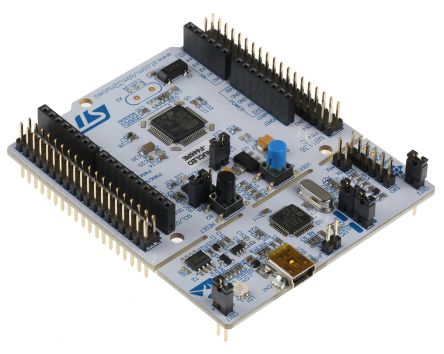
- #STMICROELECTRONICS NUCLEO F401RE SERIAL#
- #STMICROELECTRONICS NUCLEO F401RE CODE#
- #STMICROELECTRONICS NUCLEO F401RE FREE#
#STMICROELECTRONICS NUCLEO F401RE FREE#
During this period, we could provide free technical maintenance if there are any problems about our products. Each product from has been given a warranty period of 365 days. Maximum latency: 25258 usec, Minimum Latency: 12206 usec, Avg Latency: 12989 usec Here is the first result, no attempt to optimize: This is with a simple polled SPI library, not DMA. I now have a new, not SdFat, file system library running well enough to do a first benchmark. I am using a stock Adafruit data logging shield. Wow! The NUCLEO-F401RE is really fast with just polled SPI. Its three 12-bit ADCs can run in interleaved mode to digitize a signal at up to 7.2 MSPS.Įdit: Just checked and Future electronics now sells the 32F429IDISCOVERY for $24.00, about the same as an Uno. The external SRAM has a 16-bit data bus and runs at 80 MHz. 256 KB internal RAM, 8 MB external SRAM, 2 MB flash, 180 MHz clock, 2.4" TFT touch screen. I also bought a 32F429IDISCOVERY board for $33.60. 4-bit SDIO should be very fast since it should run at 50 MHz. I plan to support SD on SPI, SD on 4-bit SDIO, and USB flash drives. I have almost finished porting a new FAT32/FAT16/FAT12 generic file system to the STM32. The 12-bit ADC seems to be very accurate. I have tested the ADC on these boards and it is at least 50 times faster than the Uno, 2.4 MSPS.

There are three SPI controllers, three I2C controllers, and three UARTs. It is faster, 100 MHz, has more SRAM, 128 KB, and 512 KB of flash. There is a new NUCLEO-F411RE ($10.33 from Future Electronics).
#STMICROELECTRONICS NUCLEO F401RE SERIAL#
This does not interrupt the connection to the serial monitor since there is a second STM32F103 that handles the serial monitor, programming flash, and debug.

I now program flash by drag and drop of the apps. I continue to be pleased with the Nucleo boards. STM Studio reads data through the ST-Link SWD debug port so it does not interfere with the real-time behavior of applications. STMStudio reads the elf file generated by the linker to find and displays variables in real-time. Several people have posted Makefiles templates to build projects generated by STM32CubeMX.
#STMICROELECTRONICS NUCLEO F401RE CODE#
STM32CubeMX creates a project with the generated start-up code and copies needed library code to the project. The power-consumption wizard estimates the application's power usage.

The peripherals-and-middleware wizard aids configuration to avoid unusable settings. The user interface is a diagram of the clock tree and you just edit this diagram. The clock-tree wizard assigns clocks and performs dynamic validation.

The STM32CubeMX pin-out wizard assists pin assignment to avoid conflicts and has a constraints solver. STM32CubeMX is a graphical configuration tool that automates configuration and generation of STM32 initialization C code. STM32CubeMX is a big improvement over previous ST configuration tools. I have started using STM32CubeMX to configure Nucleo projects and several other STM32 boards.


 0 kommentar(er)
0 kommentar(er)
